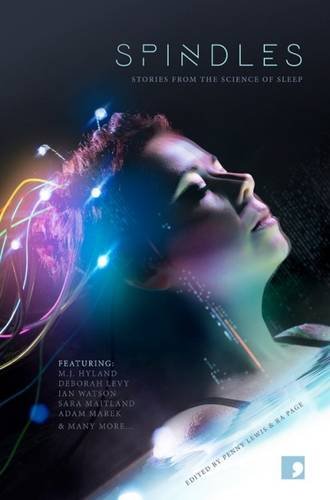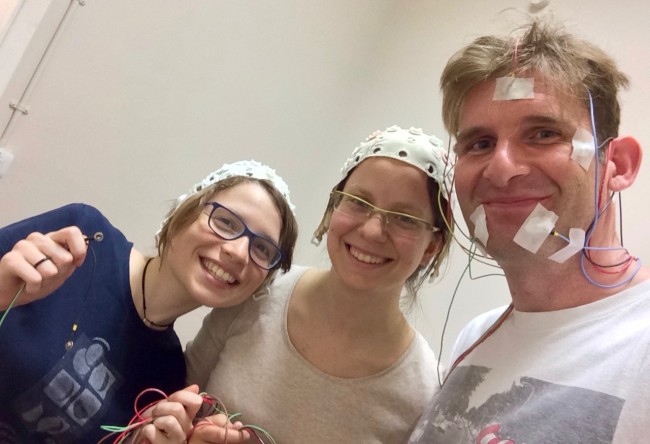Earlier this year, I got to spend a night in a sleep lab at Manchester University for a new story commission. It was for Spindles: Stories from the Science of Sleep – the latest in Comma Press’s series of science-inspired fiction. When I first found out I’d get to have electrodes glued to my head and be part of an experiment, I was so excited, but I didn’t know what I’d let myself in for.
This is how the night went:
• 3pm: arrive at Manchester Uni and meet Penny Lewis, who runs the Neuroscience and Psychology of Sleep lab. She bombards me with fascinating information about the latest in sleep research. Her field is ‘Sleep Engineering’ – manipulating sleep to enhance its beneficial impacts on health and cognition. This is amazing stuff – improving people’s memories and psychological health by stimulating their brains while they’re asleep.
5pm: Penny introduces me to Maria-efstratia Tsimpanouli and Isabel Hutchison, two of her PhD students who’ll be up all night experimenting on a volunteer and taking me through the same process so I can experience it first hand. One of the other students in the lab has just returned from Japan with a bottle of sake and some micro-biscuits, so we scoff these and chat about everything from sleep phases to Hypnos, the Greek god of dreams.
7pm: The student volunteer arrives. Maria and Isabel get her to fill in questionnaires, then glue the electrodes to her head. She gets changed into her pyjamas, then runs through a few memory tests while Maria and Isabel monitor her readings on an EEG in the next room. I watch, take notes, and as it gets later and later, start to yawn.
11pm: I want to go to bed. It’s been a long day and my brain is desperate to sleep so it can process all this new information. The volunteer is just going to sleep now, and my experiment has yet to begin.
12pm: I sit in the observation room chatting with Maria and Isabel. They’re waiting for the volunteer’s EEG to show that she has gone into slow-wave sleep – they explain that in this stage of sleep, the brain replays events from the day, a process which transports them from short-term memory to long-term. During this stage, the sleep scientists play a series of tones, which were also played during the memory test, forcing the volunteer’s brain to replay the memories, thereby increasing retention of those memories. This kind of sleep stimulation has been shown to improve memory and enable people to learn new skills more effectively. Another effect of improved memory processing is that it reduces the intensity of the emotions associated with it. This could make it an effective treatment for something like PTSD, which is caused by a person’s inability to process traumatic memories.
1am: How do sleep scientists cope with these late nights? It’s ironic that they’re sacrificing their own sleep to study other people’s. ‘Sleep is like a bank,’ Maria says, ‘you have to make a deposit every night or problems build up.’ They both do this at least a couple of times a week. Stay up all night, that is. I feel lucky that being a participant in their experiment means I’ll HAVE to go to sleep, and won’t need to stay awake all night with them. I think about how good it will feel to be horizontal, with my head on a pillow.
1:30am: Maria says it’s time to begin my experiment. The process with the volunteer took over three hours. I’m really hoping I can do an abbreviated form of it because I’m drunk with tiredness and my vision is all fizzy.
1:40am: I get changed into my jim-jams. Brush my teeth. Maria and Isabel put a plastic cap on my head and use the holes in it to mark the positions for the electrodes using a red eye-liner pencil. They glue 22 electrodes onto my scalp, then tape a bunch more to my face.
2am: I’m so tired! The memory test is about to begin. Maria explains that pictures will appear on a computer screen, one at a time, at first filling the whole screen and then shrinking down to thumbnail size. Each thumbnail image will land in a different position on a grid. I have to memorise the final position of the image on the screen. A sound will be played along with each image. Maria says there will be about 200 images, some of them neutral in subject and some of them chosen to trigger negative emotions. Okay…
2:15am: Maria leaves me to it. I click to begin the test. The first image to appear is a kid with a balloon, accompanied by the sound of children playing. The second image is of a mangled hand in a pool of blood. Broken bones stick through the skin. This image is accompanied by a loud scream. Holy crap. How many images did Maria say there’d be?
3am: The memory test takes about 45 minutes. Every second or third image and sound combination is deeply disturbing: murder victims, a woman being abducted into a van, a dead body in the water with a head injury, a guy putting a gun to the head of another guy on a train, a burned corpse in a car, a vicious dog barking, someone being killed in an electric chair, a plan crash, a puddle of vomit, a filthy toilet. They go on and on relentlessly, made even worse by the associated sounds, and by the fact that I never know whether the next image will be a man playing a guitar, or a deformed kitten. And worst of all, I have to really concentrate on the images to try and remember their position on the screen. This. Is. Ghastly. I. Want. My. Teddy.
3:45am: I have to run the whole memory test again to see how much I’ve improved.
4:30am: I’m done. I’m so freaked out, my head filled with grisly images. What the hell are my dreams going to be like? Maria puts the portable EEG machine on a strap round my neck so I can go to the loo, feeling emotionally wounded, and trailing all my wires like an electric medusa.
4:25am: I switch off the light and go to sleep.
7:30am: I get up. Maria has gone home to get a couple of hours’ sleep before she has to leave to catch a flight, but Isabel is here, having been awake all night. Unfortunately the volunteer didn’t manage to sleep well enough for her to run the experiment, so she has no usable data. She says that’s just the way it goes sometimes. If I were a proper case study for Maria and Isabel’s research, I would have had sounds played to me while I was asleep, designed to force my brain to replay my memories of the test. I would then have had to redo the memory test with the same images for a third time upon waking, to see how much my memory had improved. The theory being that people who’ve been stimulated with sounds during the test and during sleep, perform better in the morning. Thankfully, I’m just a writer doing research, so Isabel takes all the wires off my head and I get to go shower in the basement loos of Manchester Uni. It takes ages to pick all the tape and glue out of my hair.
8:30am: I leave the university in search of coffee. The sun is shining. I find a nice place round the corner where they have french toast with bacon and maple syrup. I am glad to be alive.
 10:am: On the train back to London I read through dozens of pages of notes. Yes, this was a horribly disturbing experience, but it was totally worth it, because the beginnings of a story idea come, about a sleep scientist employed by a space research institute to help lab-chimps cope with the testing regime they have to undergo. The joy of having a new story idea I’m excited about is the perfect antidote to my night in the sleep lab.
10:am: On the train back to London I read through dozens of pages of notes. Yes, this was a horribly disturbing experience, but it was totally worth it, because the beginnings of a story idea come, about a sleep scientist employed by a space research institute to help lab-chimps cope with the testing regime they have to undergo. The joy of having a new story idea I’m excited about is the perfect antidote to my night in the sleep lab.
Big thanks to Penny, Maria and Isabel for a weird, inspiring evening. And thanks to Ra Page for commissioning me for another, amazing, science-into-fiction book.
Spindles: Stories from the Science of Sleep is out now, from Comma Press.
You can read Zoe Gilbert’s blog post about her contribution to Spindles, here.
And you can read about other science-into-fiction short story anthologies I’ve been commissioned for here: Beta-Life, Biopunk, Litmus, When it changed, and The New Uncanny.

Blimey you’re brave – who knows what they really did to you? Tap-tap-tap – Mark – are you there Mark – tap-tap-tap 🙂 So did you have bad dreams in the end?